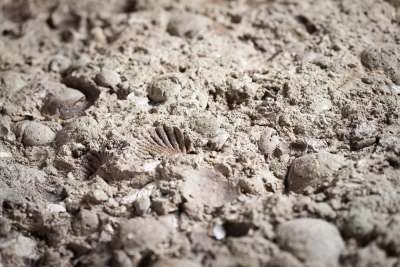Fossil sea floor
This fossilised sea floor with impressions of shallow marine sea shells was found when a bypass was built near Kingsteignton in south Devon.
The upper Greensand deposits of Haldon Hill and around Kingsteignton are the most westerly remains/relicts/outcrops of Cretaceous deposits in England. The fossiliferous sandstones are remnants of a once much wider extent. Outcrops of the Upper Greensand also occur in the Blackdown Hills and on the East Devon Plateau.
A rising sea deposited the sandstones. During the Cretaceous world-wide sea levels rose and the higher terrains of SW England were flooded. The marine transgression probably culminated in a almost total submergence of Devon and Cornwall. Dartmoor possibly remained as an island. The sandy deposits contain cherts, thin clay seems, and shell beds that are largely made up of fragmentary oyster and other bivalve shells (Exogyra sp. and Pectenoids). The preserved fauna is largely a bottom-dwelling, near shore marine assemblage, including thick-shelled bivalves and corals of littoral type. The presence of cross-bedding, gravel bands, primary glauconite, beds of shell debris and arthropod burrows indicate deposition in relatively shallow water, periodically subject to strong waves and currents.
The upper Greensand deposits of Haldon Hill and around Kingsteignton are the most westerly remains/relicts/outcrops of Cretaceous deposits in England. The fossiliferous sandstones are remnants of a once much wider extent. Outcrops of the Upper Greensand also occur in the Blackdown Hills and on the East Devon Plateau.
A rising sea deposited the sandstones. During the Cretaceous world-wide sea levels rose and the higher terrains of SW England were flooded. The marine transgression probably culminated in a almost total submergence of Devon and Cornwall. Dartmoor possibly remained as an island. The sandy deposits contain cherts, thin clay seems, and shell beds that are largely made up of fragmentary oyster and other bivalve shells (Exogyra sp. and Pectenoids). The preserved fauna is largely a bottom-dwelling, near shore marine assemblage, including thick-shelled bivalves and corals of littoral type. The presence of cross-bedding, gravel bands, primary glauconite, beds of shell debris and arthropod burrows indicate deposition in relatively shallow water, periodically subject to strong waves and currents.
Object Summary
- Accession Loan No.
- 354/1974
- Collection Class
- Fossils
- Collection Area Region
- Northern Europe
- Collector Excavator
- Devon County Council
- Common Name
- fossil sea floor
- Simple Name
- fossil


